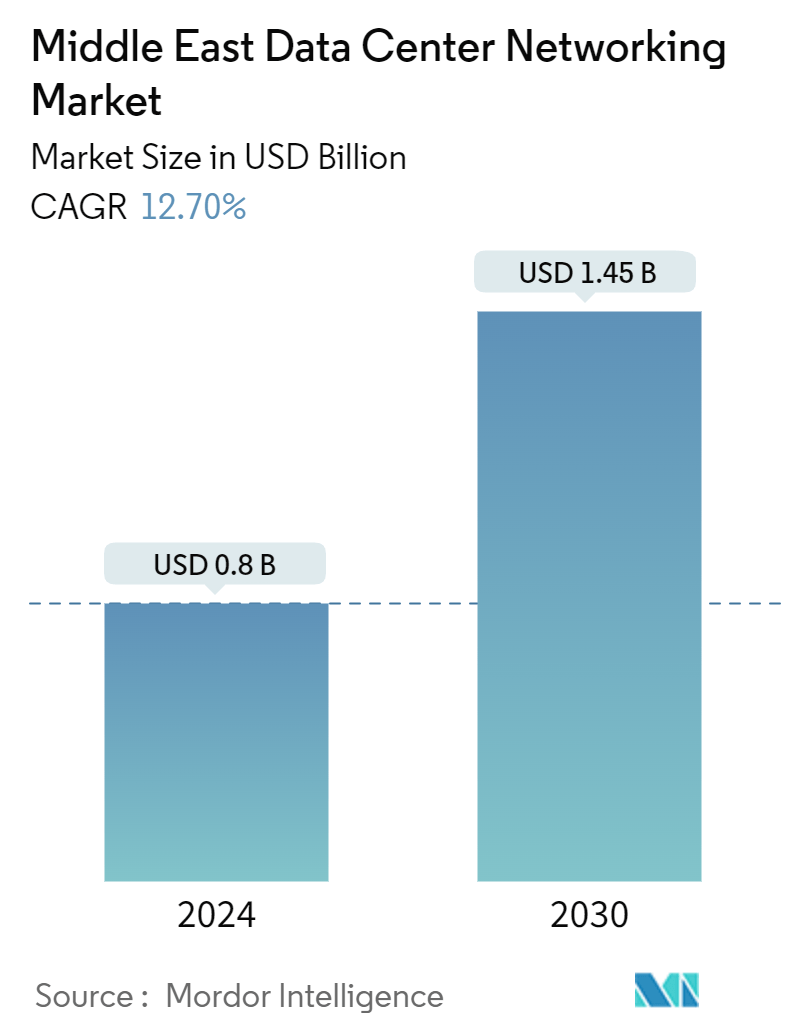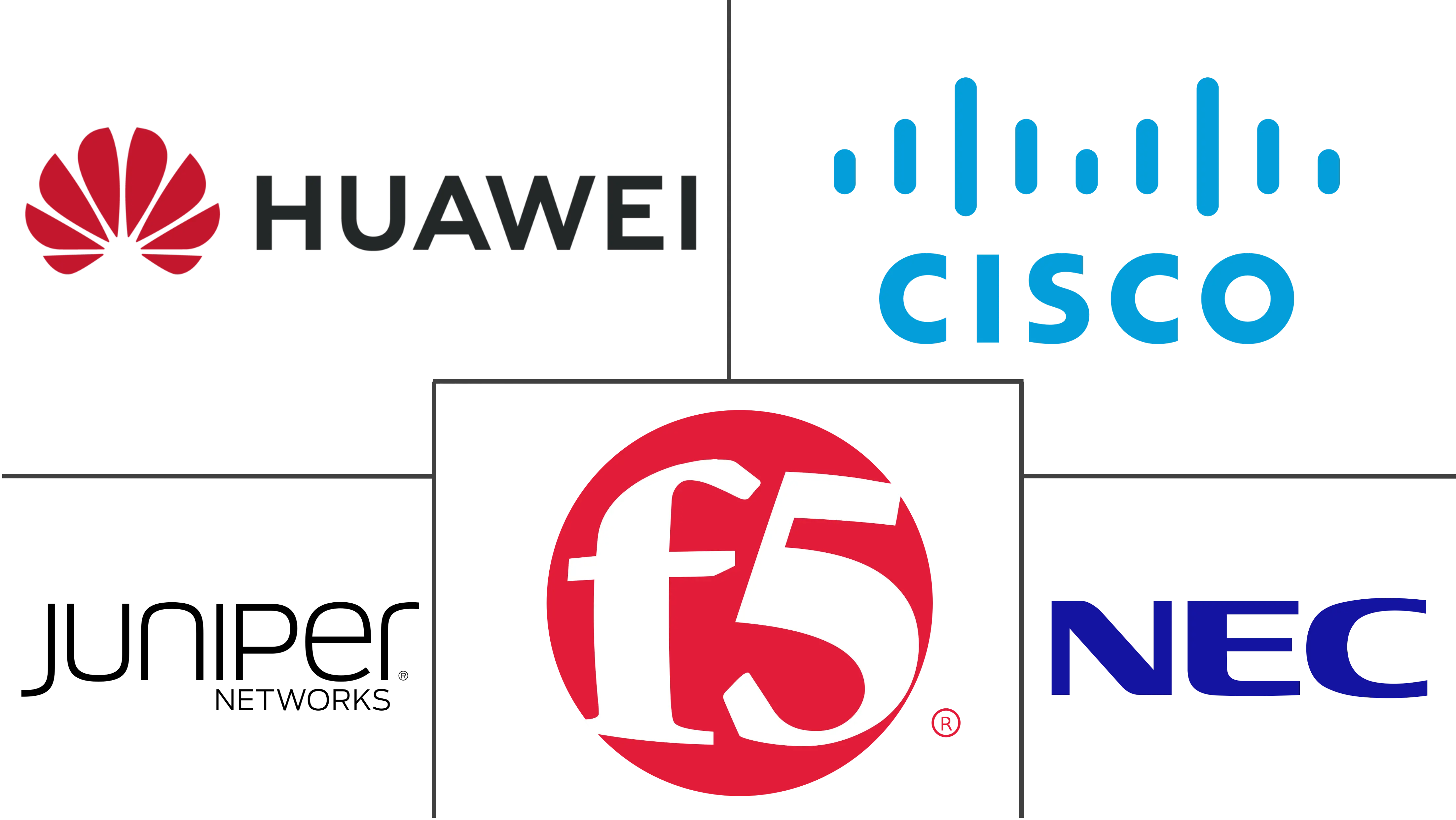Market Size of Middle East Data Center Networking Industry

| Study Period | 2019 - 2030 |
| Base Year For Estimation | 2023 |
| Market Size (2024) | USD 0.8 Billion |
| Market Size (2029) | USD 1.45 Billion |
| CAGR (2024 - 2030) | 12.70 % |
| Market Concentration | Low |
Major Players
*Disclaimer: Major Players sorted in no particular order |
Middle East Data Center Networking Market Analysis
The Middle East Data Center Networking Market size is estimated at USD 0.8 billion in 2024, and is expected to reach USD 1.45 billion by 2029, growing at a CAGR of 12.70% during the forecast period (2024-2029).
The Middle East is witnessing an expansion in tower infrastructure sharing to reduce costs and improve network coverage. A few years back, Saudi Telecom Company (STC) and Zain Saudi Arabia announced an agreement to share their network infrastructure, including telecom towers. The Middle East is also beginning to increase local capacity to improve routing efficiencies. With the increase in data center infrastructure, the demand for networking solutions is expected to increase.
- The upcoming IT load capacity of the Middle East data center construction market is expected to reach 2,059.5 MW by 2029. The region's construction of raised floor area is expected to increase 9.7 million sq. ft by 2029.
- The region's total number of racks to be installed is expected to reach 496K units by 2029. Saudi Arabia is expected to house the maximum number of racks by 2029.
- There are close to 26 submarine cable systems connecting the Middle East, and many are under construction. One such submarine cable that is estimated to start service in 2024 is Blue, which stretches over 4,696 km with a landing point in Tel Aviv.
Middle East Data Center Networking Industry Segmentation
Data center networking refers to the set of technologies, protocols, and hardware used to connect physical and network-based devices and manage the network infrastructure, storage, and processing of applications and data. Data center networking is very critical for 100% uptime of data centers. In the current web-connected world, business workloads are executed on single computers, hence leading to the need for data center networking. Networks provide servers, clients, applications, and middleware with a standard plan to stage the execution of workloads and also to manage access to the data produced.
The Middle East data center networking market is segmented by component type (product (ethernet switches, router, storage area network (SAN), application delivery controller (ADC), and other networking equipment) and services (installation & integration, training & consulting, and support & maintenance)), end-user (IT & telecommunication, BFSI, government, media & entertainment, and other end-users), and country (Israel, Saudi Arabia, UAE, and the Rest of Middle East)
The market sizes and forecasts are provided in terms of value (USD) for all the above segments.
| By Component | |||||||
| |||||||
|
| End-User | |
| IT & Telecommunication | |
| BFSI | |
| Government | |
| Media & Entertainment | |
| Other End-Users |
| ***Country | |
| Israel | |
| Saudi Arabia | |
| United Arab Emirates |
Middle East Data Center Networking Market Size Summary
The Middle East data center networking market is experiencing significant growth, driven by the expansion of digital infrastructure and increased demand for networking solutions. The region is witnessing a surge in tower infrastructure sharing to enhance network coverage and reduce costs, with key players like Saudi Telecom Company and Zain Saudi Arabia leading such initiatives. The construction of data centers is on the rise, with substantial increases in IT load capacity and raised floor area anticipated in the coming years. The proliferation of submarine cable systems, including the upcoming Blue cable, is set to further bolster connectivity. Telecom providers are at the forefront of this growth, propelled by the establishment of mobile virtual network operators, the expansion of fiber-based networks, and the liberalization of the telecom sector. The rapid adoption of 4G and the impending rollout of 5G services are encouraging telecom suppliers to invest heavily in data center infrastructure.
In the United Arab Emirates, the demand for cloud storage and digital banking is driving the expansion of data center networking solutions. The UAE-IX in Dubai stands as a pivotal internet exchange, supporting the growing IP traffic and enhancing user experiences. The region's shift towards digitalization is attracting significant investments, with major players like Avaya Holdings Corp. and Microsoft introducing cloud-based services. The market is characterized by fragmentation, with key industry leaders such as Huawei Technologies Co. Ltd., Cisco Systems Inc., and F5 Networks Inc. competing for market share. These companies are leveraging strategic collaborations and innovative solutions, like F5's Multi-Cloud Networking capabilities and VMware's SD-WAN solution, to enhance connectivity and security across diverse networks. As the demand for application delivery controllers and cloud-enabled applications rises, the Middle East data center networking market is poised for continued expansion.
Middle East Data Center Networking Market Size - Table of Contents
-
1. Market Dynamics
-
1.1 Market Overview
-
1.2 Market Drivers
-
1.2.1 Increasing Need of Cloud Storage
-
1.2.2 Increasing Cyberattacks Among Enterprises
-
-
1.3 Market Restraints
-
1.3.1 Increasing Network Complexity
-
-
1.4 Value Chain / Supply Chain Analysis
-
1.5 Industry Attractiveness - Porter's Five Forces Analysis
-
1.5.1 Threat of New Entrants
-
1.5.2 Bargaining Power of Buyers/Consumers
-
1.5.3 Bargaining Power of Suppliers
-
1.5.4 Threat of Substitute Products
-
1.5.5 Intensity of Competitive Rivalry
-
-
1.6 Assessment of COVID-19 Impact
-
-
2. MARKET SEGMENTATION
-
2.1 By Component
-
2.1.1 By Product
-
2.1.1.1 Ethernet Switches
-
2.1.1.2 Router
-
2.1.1.3 Storage Area Network (SAN)
-
2.1.1.4 Application Delivery Controller (ADC)
-
2.1.1.5 Other Networking Equipment
-
-
2.1.2 By Services
-
2.1.2.1 Installation & Integration
-
2.1.2.2 Training & Consulting
-
2.1.2.3 Support & Maintenance
-
-
-
2.2 End-User
-
2.2.1 IT & Telecommunication
-
2.2.2 BFSI
-
2.2.3 Government
-
2.2.4 Media & Entertainment
-
2.2.5 Other End-Users
-
-
2.3 ***Country
-
2.3.1 Israel
-
2.3.2 Saudi Arabia
-
2.3.3 United Arab Emirates
-
-
Middle East Data Center Networking Market Size FAQs
How big is the Middle East Data Center Networking Market?
The Middle East Data Center Networking Market size is expected to reach USD 0.8 billion in 2024 and grow at a CAGR of 12.70% to reach USD 1.45 billion by 2029.
What is the current Middle East Data Center Networking Market size?
In 2024, the Middle East Data Center Networking Market size is expected to reach USD 0.8 billion.

